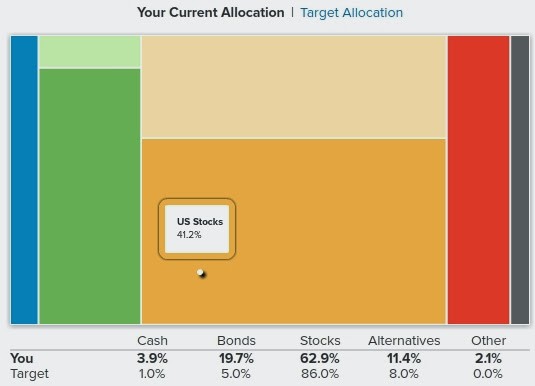When and How to Rebalance Your Portfolio Can I Retire Yet
Post on: 9 Июнь, 2015 No Comment

Rebalancing your portfolio means adjusting the current asset allocation, moving it closer to some previously-chosen target. In theory, rebalancing captures a portion of the profits earned by your winning investments, and reinforces your losing investments so they can shine in their own time. The majority of financial experts advocate some form of rebalancing. And virtually none of them agree on how to do it!
As we search for perspective on rebalancing, there will be two obvious questions: (1) When should you do it? and (2) How should you do it?
To resolve these questions, well explore what a range of experts have to say on the subject. Well consult with some of the oldest and newest names in personal finance, with some fellow bloggers, and with some academics.
And finally well ask a third, equally important, and perhaps surprising, question: Should you rebalance at all?
When to Rebalance
Lets start by reviewing what others have to say on the question of when you should rebalance: how frequently or under what conditions should you undertake to rebalance your portfolio?
In Work Less, Live More: The Way to Semi-Retirement , one of the first books to fully address early retirement, Bob Clyatt describes rebalancing as a crucial component of maintaining a portfolio. Clyatt points out that selling shares of winners and buying up more of losers, to bring your portfolio back to its target allocation, ensures you are buying low and selling high. Rebalancing helps to overcome the psychological pitfall of riding a winning investment too long, dumping a losing one too soon, or trading too frequently. Clyatt sites studies showing that rebalancing once a year is about the right frequency, and that doing so more frequently is often counterproductive. He goes on to say that letting assets go for 2-3 years between rebalancing appears to increase returns, though it may mean taking on more risk than desired.
In Fail-Safe Investing: Lifelong Financial Security in 30 Minutes , Harry Browne a conservative and experienced money manager, once the Libertarian presidential candidate advocates a permanent portfolio made of equal parts (25% each) stocks, bonds, gold, and cash. For this portfolio, he advocates an annual rebalancing, but only if one or more of the allocations has drifted significantly, by more than 10% in either direction: comprising less than 15% or more than 35% of the total portfolio. In that case, he advocates selling the leaders and investing the proceeds in the laggards, to restore each part to an equal 25%. He suggests an annual check of the portfolios value, and, if all four investments are within that 15-35% range, leaving it alone. During the year, if you happen to notice a big runup in prices, enough to push one investment out of that range, you may want to rebalance. But Browne doesnt insist on this more frequent rebalancing.
In The Random Walk Guide To Investing , Burton Malkiel twice chair of the Princeton University economics department suggests ignoring small changes in asset allocation plus or minus 10% to 15% in the value of one asset. He mentions rebalancing in response to sharp market declines, in order to buy assets at reduced prices, but suggests no time frames, other than doing so in a disciplined way. He ends with the advice not to be trigger happy, but to rebalance at least once a year.
In Can I Retire. How Much Money You Need to Retire and How to Manage Your Retirement Savings , blogger and CPA Mike Piper writes that the ideal frequency for rebalancing is one that gives the stock market time to run through one half of a bear/bull cycle. The historical lengths of bull and bear markets vary considerably and are unpredictable. Usually they last for longer than one year. Therefore, rebalancing more frequently than once a year is likely to harm performance. Piper also points out that if the assets being rebalanced are held in a taxable account, frequent rebalancing will incur additional costs in the form of taxable capital gains. He goes on to recommend rebalancing every couple years perhaps.
In a related blog post, Piper addressed whether its better to rebalance periodically (say annually) or based on some tolerance band when the allocation to a certain asset class strays more than 5% from the target, for example.
The primary advantages to rebalancing periodically are that it is simple to understand and implement, and doesnt require constant monitoring of your portfolio. It might also reduce costs, if you have been tempted to rebalance more often than annually. The main disadvantage to rebalancing on a periodic schedule is that it could let your assets drift significantly off target and take on more risk than you intended.

Rebalancing using tolerance bands is the opposite in most respects: it ensures that your asset allocation doesnt drift far off at any time, but it requires frequent checking of your portfolio. And, if frequent rebalancing is required, that could be detrimental to returns: If you rebalance more often than the historical tendency for good asset class performers to persist (about 2-3 years according to William Bernstein ) you only hurt yourself.
Personally, Piper favors the simplicity of annual rebalancing. He feels the potential risk to his portfolio of drifting off the target allocation between annual rebalancings is less threatening than the temptation to tinker that might come with constantly checking his portfolio.
In I Will Teach You To Be Rich , a book targeted at younger investors in their accumulation phase, Ramit Sethi falls in with those recommending annual rebalancing, but he extends that slightly, recommending rebalancing every twelve to eighteen months .
The Bogleheads Guide to Retirement Planning acknowledges that there is no universal strategy for rebalancing, and it is not possible to know in advance the optimal one. The costs of rebalancing have to be weighed against your tolerance for risk. Like Piper, the Bogleheads describe two basic timing strategies: calendar-based and percentage bands. For calendar-based rebalancing, which has the advantage of simplicity, not requiring that you monitor your portfolio, they suggest a time frame of once per year. That should be long enough to avoid emotional reactions to short-term market movements. They also recommend picking a quiet season during your year, to make it easier to concentrate on your investments. Thus the traditional January rebalancing, at the tail end of the holiday season, may be ill-advised.
The Bogleheads question whether its necessary to rebalance if your portfolio is only slightly out of balance. This introduces the use of percentage bands. They mention that a commonly used band is 10% meaning that somebody with a 50% stock allocation would rebalance if their stock allocation went up or down by 5% (10% of 50). The Bogleheads note that if this approach leads to less frequent rebalancing, that could be a cost advantage in a taxable account though, in a volatile market, it could lead to more frequent rebalancing. A disadvantage is the greater effort and monitoring required. A hybrid approach would be to do annual monitoring, and only rebalance when the asset allocation has drifted outside the percentage band. This may help equalize portfolio risk and rebalancing cost.
William Bernstein, writing in The Four Pillars of Investing: Lessons for Building a Winning Portfolio , recognizes that the question of How often to rebalance? is one of the thorniest in investing. He cites research showing that the tendency for previous leaders to do worse in the future, and vice-versa, appears to be strongest over approximately 2-3 years. Indeed, over periods of a year or less, the reverse seems to be true: contraindicating annual rebalancing. Thus, rebalancing too often is the more likely mistake. According to Bernstein, the data indicates that the optimal interval for rebalancing is every 2-5 years (much longer than the usual advice), but this data is very sensitive to the assets used and the years studied.
After listening to these experts, we might summarize the pros and cons of rebalancing periodically versus by percent band like this:














